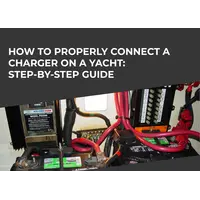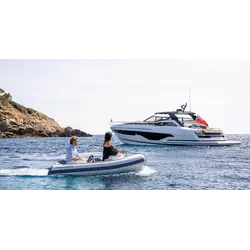The sailing season is in full swing, and in order for the upcoming cruise to become an enjoyable journey, and not a test, it is necessary to prepare for sailing carefully and in advance. Of course, the level of preparation of the yacht largely depends on the complexity and range of the chosen route. Whether it's a short boat trip or a long cruise, following certain guidelines will help you avoid trouble on board and get the most out of your sailing trip. How to prepare a yacht for setting sail and what to pay attention to first of all – find out in our article.
The Day before Departure
Route Detail
Since you have probably decided on the travel route and the composition of the crew, we recommend that you draw up a detailed travel plan: how long are you going to stay at sea, which bays and ports are you planning to visit. If you are planning a trip along a coast that you are not familiar with, study the geographical nuances of that area, download maps and determine possible places for mooring at ports. Please be aware that due to sudden changes in water depths in some water areas, not all ports accept yachts with a high draft. Knowing the exact parameters of the vessel, you will be able to determine the most suitable places for mooring.
External Inspection of the Vessel and Equipment
Before launching the vessel, the first thing to pay attention to is the integrity of the hull and equipment. If the yacht has sails, make sure that the rigging is set up correctly, the mast is level, the sails are intact and perfectly stretched, otherwise all deviations and problems will affect the maneuverability and speed of the vessel, which will become very problematic to manage. Standing rigging must be firmly and securely fixed, anchor and mooring equipment must be securely fastened.
Go down into the hold and inspect it for leaks. While you're in the hold, check the water tanks and pumps as well. Pay attention to the pumps – check whether the hose filters are clogged. Make sure the pump is operational.
Checking Systems and Equipment
Electronics and Navigation
In order to avoid unpleasant surprises, before the yacht leaves the shore, test the on-board electronics while still on shore, turning on all the devices on the board one by one. Start the navigation system - a significant discrepancy between the readings of the magnetic and directional compasses may indicate that the autopilot is not calibrated. Check if the devices work correctly: the echo sounder should show the depth, the anemometer - the direction and speed of the wind.
At nightfall, walk around the deck and pay attention to the yacht's lighting. Make sure that all contacts are insulated and protected from water, batteries are firmly fixed. Check the lights in the cabins and galley, make sure the navigation and position lights are on, and that everyone on your team knows where the circuit breakers and switches are located.
Engine
After inspecting the engine itself, check the gearbox oil level and engine oil level. The drive belt should be tight and there should be no worn or frayed areas. Check the hoses - they should be intact, and there should be no traces of oil in the hold. All mechanical elements must be well lubricated, nozzles and tubes should not be damaged. The seacock must be open to cool the engine.
We recommend checking the engine regularly, especially during long sea passages. This way you will not miss the leak and will react in a timely manner to any other damage to it.
Required Equipment
The yacht must be equipped with at least: an emergency tiller, a life raft, an additional anchor with a chain, a hose, a shore power cable, adapters, a bucket and a mop. Don't forget fuel canisters and a funnel for refilling. If it’s a cruising yacht, check the availability of a boat (dinghy) and oars.
Pay attention to the feed lockers and their contents. Make sure they close tightly, otherwise water will rush in during the roll, and this can lead to big trouble. If you find such a problem, do not go to sea until you fix it.
For convenience, we provide a complete list of the necessary equipment:
- anchor with rope
- towing rope,
- lifebuoy,
- sump pump,
- fire extinguisher,
- ladle bucket,
- set of tools,
- first aid kit,
- life jackets,
- buzzer,
- rocket parachute flare.
Some yacht owners install a freshwater shower on the outside of the boat. If your yacht is equipped with it, make sure that the valve is tightly closed and does not leak before sailing. Otherwise, you can lose the entire supply of fresh water - it will simply drain out into the sea. You can turn off the water by turning the tap, usually located in a specially designated place in the stern.
Cabins
Cabin equipment on a yacht is of great importance, especially when it comes to a long sea voyage. For the convenience and aesthetic pleasure of all members of the crew and guests of the vessel, take care of the availability of sets of special bed linen and fresh towels. It is necessary to check the sockets and take an additional inverter, which, if necessary, converts 12 V to the usual 220 V and allows you to charge mobile phones, tablets, cameras and other devices.
Security Systems
The sea is unpredictable, even a one-day boat trip can turn from fun into disaster in a matter of minutes. Proper preparation of the vessel for departure and compliance with water safety rules is your insurance against trouble.
Pay attention to the operability of the fire extinguishing system and make sure that the ship has life-saving equipment in case of emergency: a first aid kit, life jackets according to the number of guests and crew members, flares.
A sealed box with a first aid kit should be equipped with:
- tourniquet - 1 pc.,
- bactericidal plaster - 5 pcs.,
- sterile wipes 6*10 cm - 5 pcs.,
- iodine and a solution of brilliant green (1%) - one bottle of each product,
- validol tablets - 1 pack,
- ammonia alcohol - 1 pc.,
- sterile bandage - 1 pc.
If you have a long trip (more than 3 days), the composition of the first-aid kit must be expanded, based on the number of people on the yacht and the recommendations of the general practitioner.
We do not recommend going to the open sea without a 406 MHz EPIRB beacon. When buying it, mandatory registration is provided, so information about the vessel is automatically entered into the database of rescue services. Before leaving, make sure that the device is in good working order and that all crew members know how it works.
It is better to check and prepare the vessel in advance, at least a day before departure - this way you will have time to bring the missing elements on board, and in case of malfunctions, eliminate them in a timely manner.
Checklist - What to Buy First for a New Yacht
On the Day of Departure
Verification of Documents
Make sure that all the necessary documents are available: passports of the crew members and guests on the vessel, certificate of registration of the yacht and a valid insurance policy. Depending on the travel distance and specific water areas, it is necessary to have a crew-list on board which includes all people on the yacht and ship roles of each one of them. Pay attention to the presence of a ship's log, in which all significant events of the trip related to the operation of the vessel will be briefly but clearly recorded. If an accident occurs, it is these records that will help the captain prove that his actions were timely and appropriate.
Safety Net
When you go out to sea, be sure to let someone know which route you are taking and when you plan to return. Check the weather forecast, wind direction and swell. Be aware of the dangers of hypothermia on the high seas and prepare warm clothes for yourself and your guests. Regardless of the time of year, it is better to depart during daylight hours.
Conduct a detailed safety briefing for all participants in the sea voyage, show how the cabins are arranged, where the latrines are located, and how to use them correctly.
Each crew member must have unhindered access to the following equipment:
- repair kit for engine,
- a set of tools, including adjustable and gas wrenches, screwdrivers and pliers,
- screw cutter,
- wooden plugs for Kingstone valves,
- whistles,
- lanterns.
Fire extinguishers and life jackets must be placed in the visibility zone of all crew members and passengers of the vessel.
Regardless of the duration of the trip, when going to sea on a yacht, it is advisable to have an emergency supply of drinking water and food - in case of unforeseen circumstances. As a dry ration, products with a long shelf life are suitable: canned food, stew, biscuits and chocolate.
Make sure that your yacht is not only luxurious, but also a safe means of transportation. If you have any questions while preparing the yacht for a cruise, make a small checklist of the points from the article and place it in a conspicuous place in the cockpit - so you definitely won’t miss anything.








